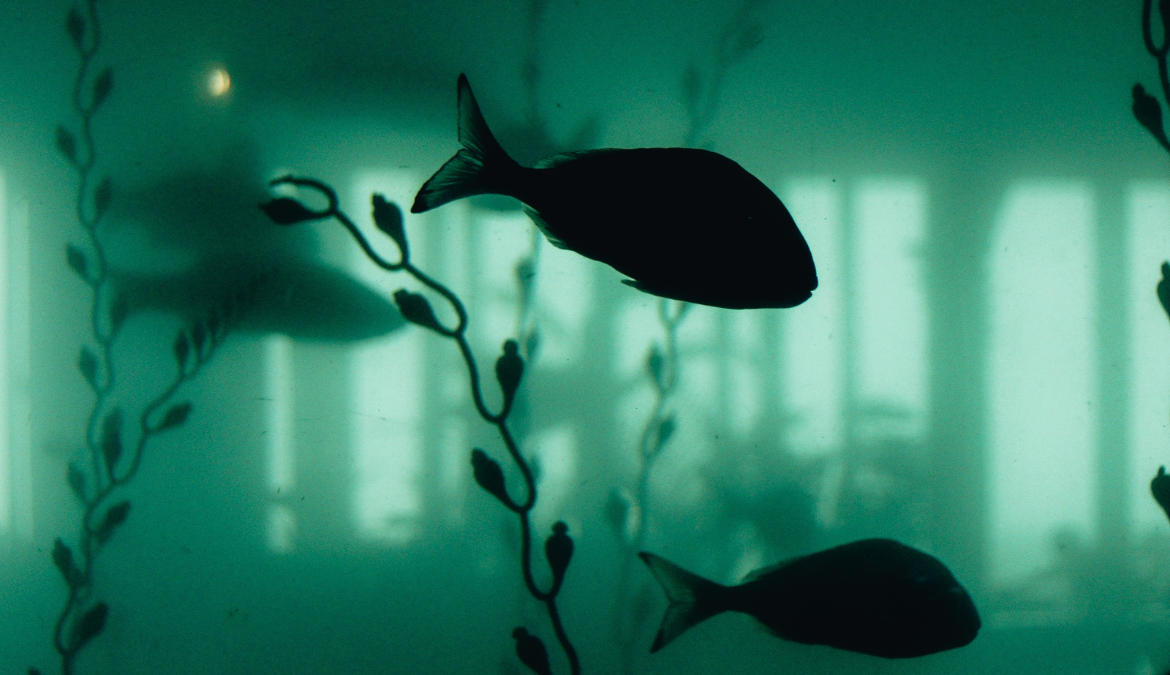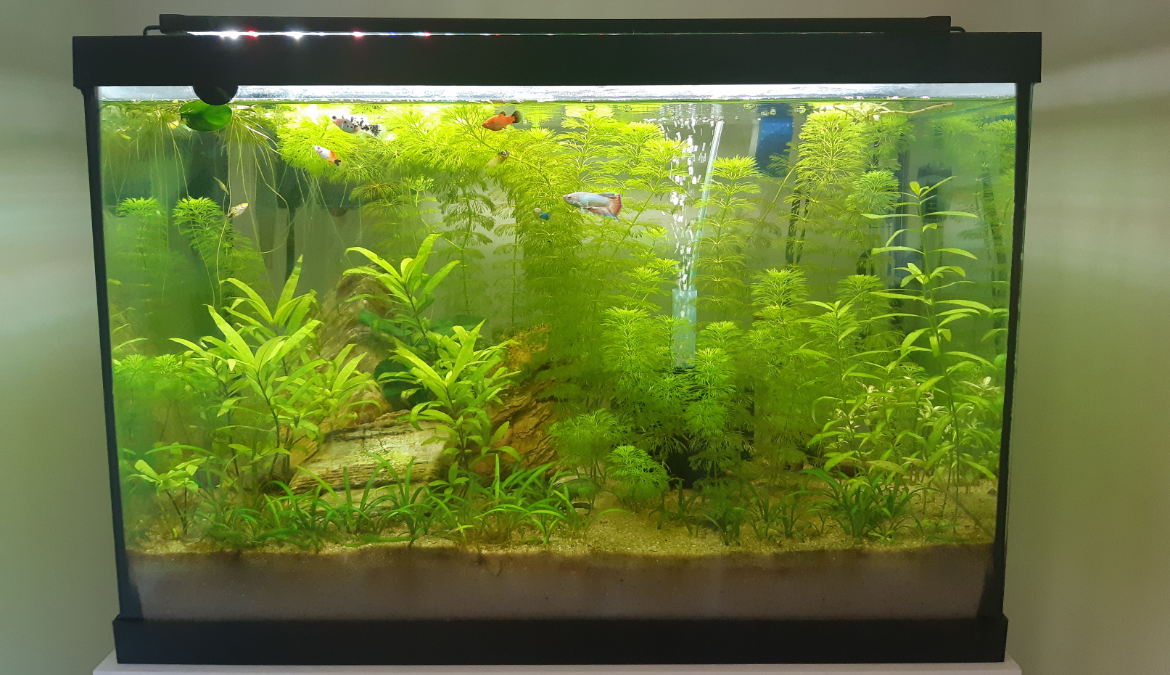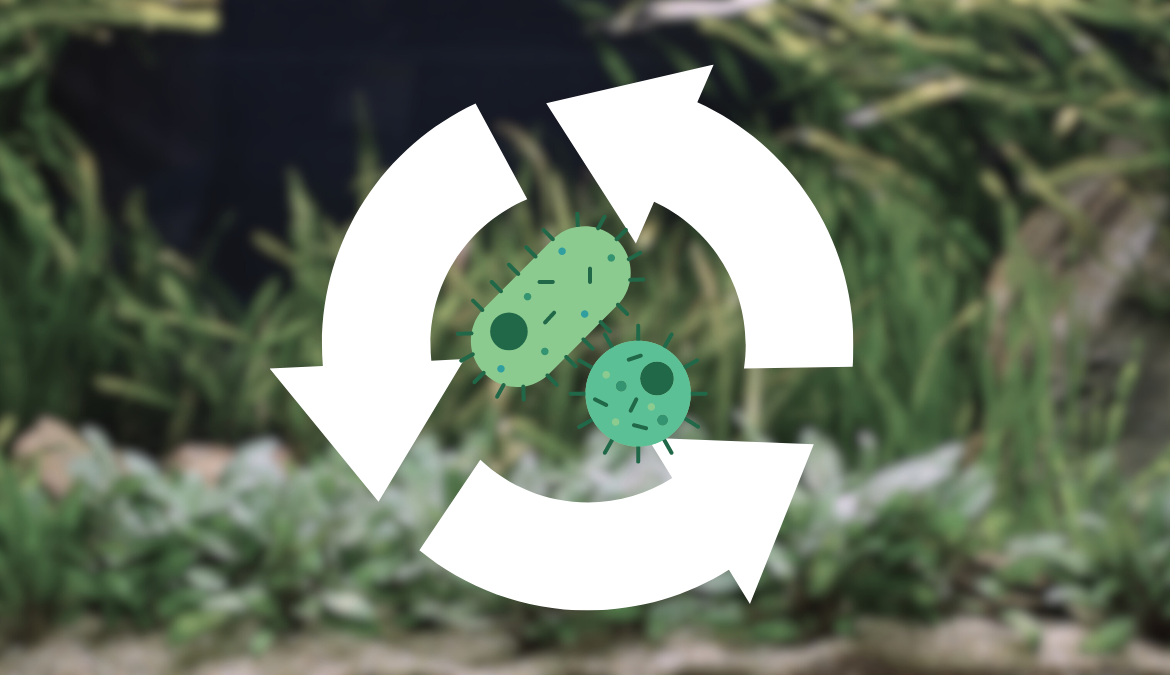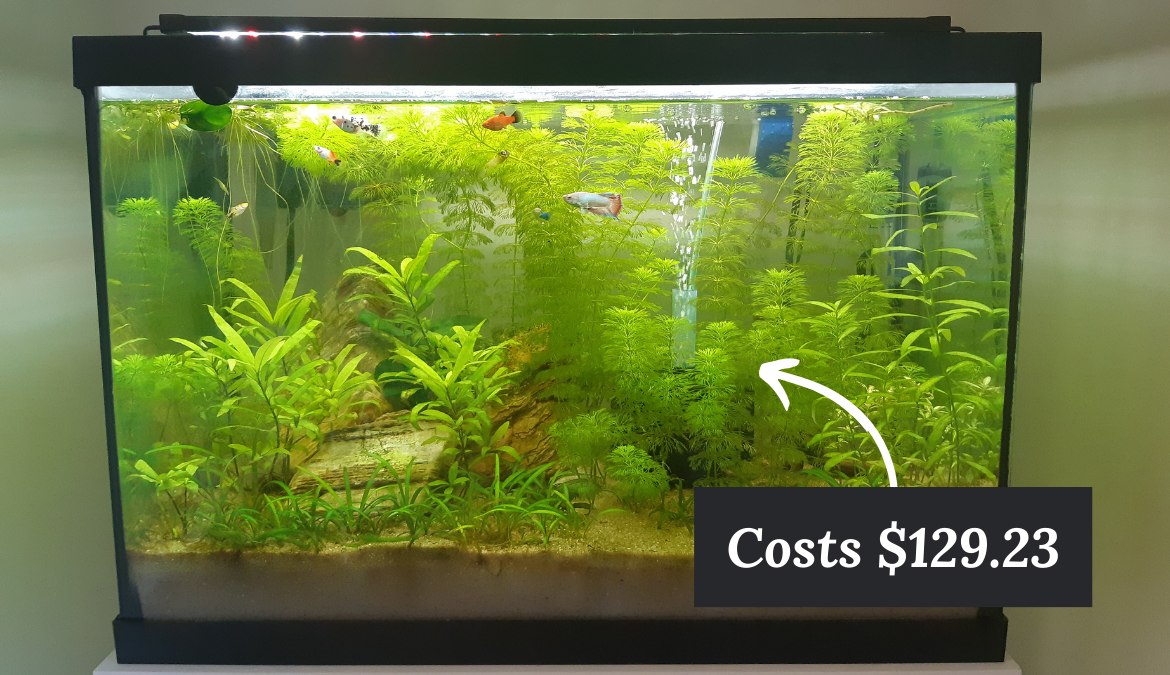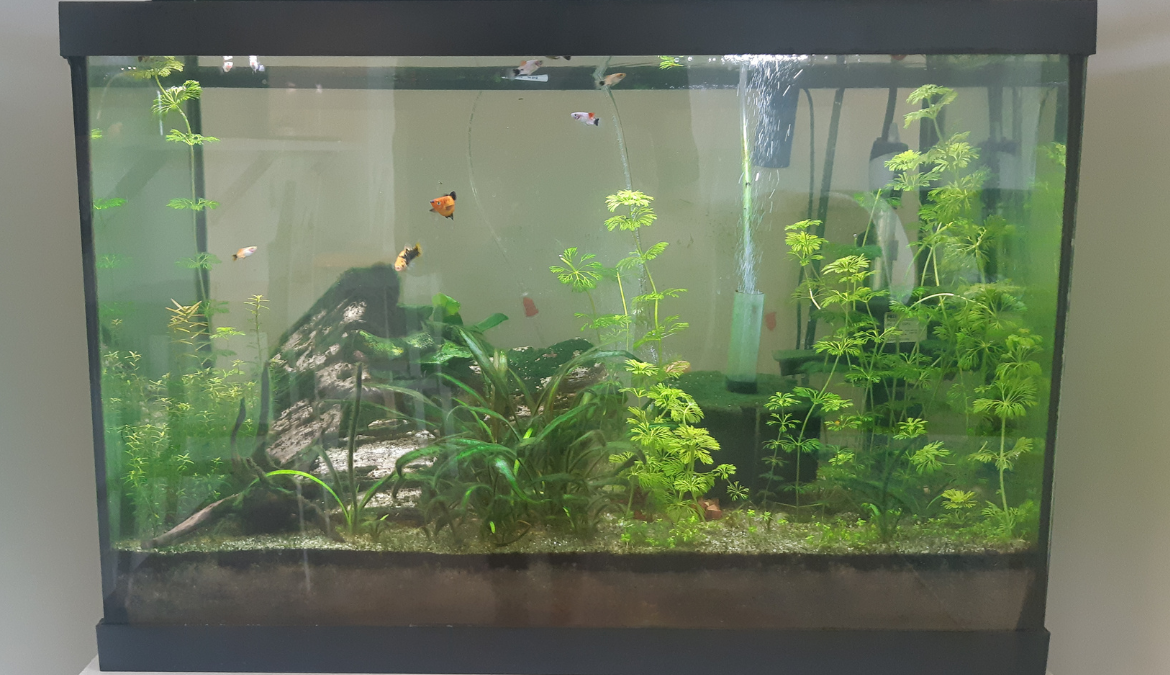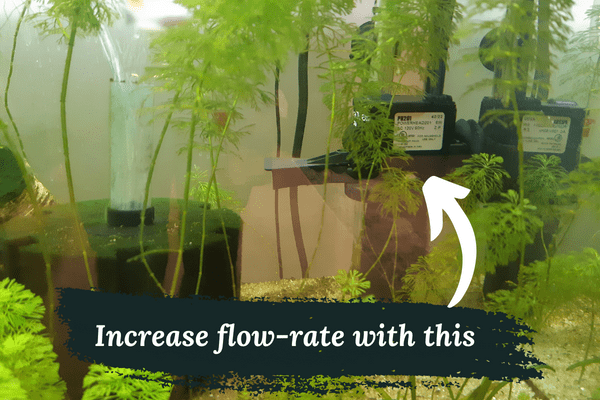There is no official definition that differentiates low-tech and high-tech aquariums. Hobbyists generally distinguish them based on the amount of light, carbon dioxide (CO2) and plant nutrients added to the tank.
High-tech tanks are characterized by their use of high-intensity lighting, artificial CO2 injection, and daily macronutrient supplementation. Low-tech tanks typically use low or medium-intensity lighting with weekly nutrient dosing and no added CO2.
Each has varying costs, maintenance requirements, benefits and drawbacks. Your choice of aquarium plants and desired effort are the main factors that will determine if a high or low-tech tank is right for you.
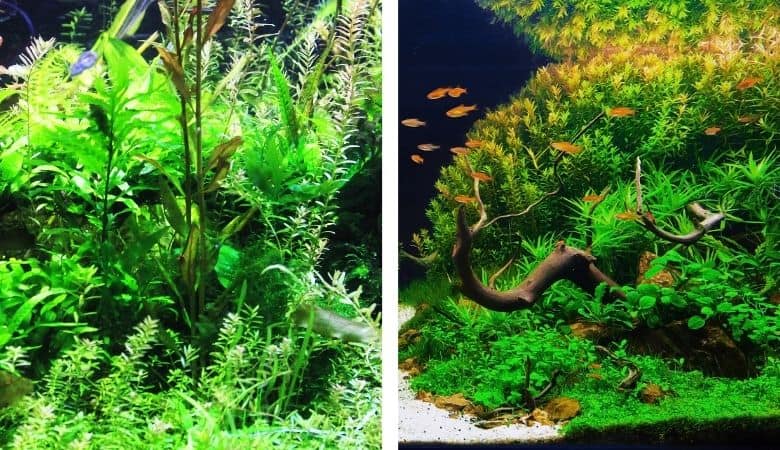
Contents
- 1 CO2 is added to high-tech tanks to improve plant growth
- 2 Intense lighting and increased CO2 go hand-in-hand
- 3 Certain plants require a high-tech setup to grow successfully
- 4 High-tech tanks require more maintenance
- 5 It is difficult to achieve vibrant red colors in low-tech tanks
- 6 High-tech tanks are more expensive
- 7 High-tech tanks can pose health risks for your fish
CO2 is added to high-tech tanks to improve plant growth
The most significant difference between the two types of aquariums is the use of artificially injected CO2.
Low-tech tanks rely on the natural CO2 levels present in your tap water and from the gas exchange that occurs at the surface of your tank’s water.
High-tech tanks require you to buy a CO2 system which injects pressurized CO2 directly into your tank. These systems usually cost between $200-$300 on average and require maintenance and refills.
Why is a CO2 system necessary?
Plants use CO2, light and macronutrients (such as nitrogen, phosphate, magnesium and calcium) to achieve photosynthesis and grow.

Generally speaking, larger amounts of these three ingredients will allow plants to grow more quickly and lush.
Therefore, a CO2 system helps you grow plants more successfully.
Intense lighting and increased CO2 go hand-in-hand
Plants require a balanced amount of light, CO2 and macronutrients to grow successfully. Imbalances among these three ingredients will cause algae growth, which is usually not desired.
This balancing act is the reason high-tech tanks typically require both a CO2 system and high-intensity lighting.

Adding one or the other will likely create aquarium imbalances. But together, they can create a balanced environment that’s ideal for plant growth.
With low-tech tanks, you can get away with low or medium-intensity lights, no added CO2 and minimal macronutrient supplementation. This makes it a much easier and more cost-effective planted tank method.
Certain plants require a high-tech setup to grow successfully
Some plants, such as rotala macrandra and hemianthus callitrichoides (AKA, dwarf baby tears), demand more CO2 and light than is typically present in an aquarium.

It would be difficult for these plants to survive in low-tech systems without added CO2 and light.
Other plants, such as rotala rotundifolia and helanthium tenellum, do not require added CO2 or light, which means they will grow in low-tech setups.
However, many of these low-tech plants will appear more luscious and show vibrant colors when planted in a high-tech environment.
A high-tech aquarium may be important if you desire plants that have specific CO2 and light requirements.
High-tech tanks require more maintenance
High-tech tanks will cost more of your time and money due to frequent maintenance and increased resource usage.
For starters, you will be required to trim your plants more frequently because of their rapid growth.
The rapid consumption of macronutrients will also require you to dose liquid fertilizer on a daily basis, increasing your fertilizer costs. Low-tech tanks may only require dosing once per week.
Your high-tech tank will also require more frequent water changes. This is because rapid plant growth increases ammonium build up.
Although ammonium is taken care of by beneficial bacteria, it is a catalyst for algae blooms to occur.
Generally speaking, a high-tech system will demand a more meticulous attention-to-detail to prevent imbalances.
It is difficult to achieve vibrant red colors in low-tech tanks
It is believed that plants display their beautiful red color as a form of sunscreen to protect against intense light. Therefore, high-intensity lighting is often required to achieve the bright and vibrant red colors you see in many showroom aquariums.

As we know from before, high-intensity lights require CO2 for balance and to protect against algae outbreaks.
Red coloring is also achieved with iron supplementation, which wouldn’t be considered “high-tech.” However, you’ll have more success bringing out red colors with light and CO2.
High-tech tanks are more expensive
CO2 equipment
The equipment required for a high-tech setup will end up costing you more money than its low-tech alternative.
A common CO2 setup will include a pressurized CO2 bottle, regulator, solenoid, bubble counter, diffuser, drop checker and tubing.

Altogether this will likely cost between $200-$300 upfront, plus additional costs for CO2 canisters as they need to be replaced.
More frequent nutrient dosing
A high-tech setup will likely use the same, or similar, fertilizers as a low-tech setup. This may include both root tabs, such as API Root Tabs, and liquid fertilizers, such as Seachem Excel.
But a high-tech setup will require daily dosing, versus weekly low-tech dosing. This means you can expect to pay approximately 7 times as much on plant food.
More expensive lighting
A high-tech setup with CO2 injection will require a lighting setup with approximately 40 lumens per litre (1 watt per litre) or more. This amount of light will be sufficient for plants that demand the highest light requirements.
For example, a 100-watt light (4,000 lumens) would provide adequate light for a 100-litre (26 gallon) tank.
A 10-gallon (38 litre) tank would require a 1,520 lumens (38 watt) light.
These high-wattage lights typically start at around $200 and increase with the size of your tank.
On the other hand, a medium-light, low-tech tank could get away with 20 lumens (0.5 watts) per litre. For a 10-gallon tank, you would require a 19 watt (760 lumens) light.
These medium-wattage lights can range between $50-$200.
High-tech tanks can pose health risks for your fish
Although CO2 injection benefits aquarium plant growth, it can be highly toxic and even fatal to your fishy friends if it’s not carefully monitored.
As a rule of thumb, 30 ppm or less of carbon dioxide is a safe recommended dosage for your aquarium.
However, this rule doesn’t always apply because lower levels of dissolved oxygen in your tank will cause your fish to become more sensitive to CO2, increasing its toxicity.
If you’re new to the planted tank hobby and are planning on keeping fish, I recommend starting with a low-tech setup to learn the ropes and familiarize yourself with the planted tank basics.
If you’re committed to some additional maintenance and costs, then a high-tech setup will allow you to create a very expressive and jaw-dropping aquarium.


